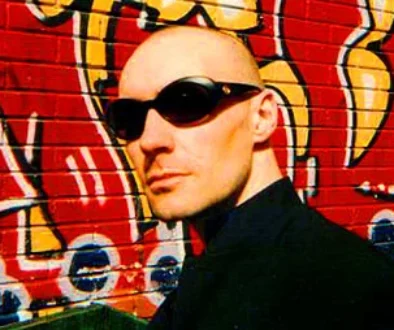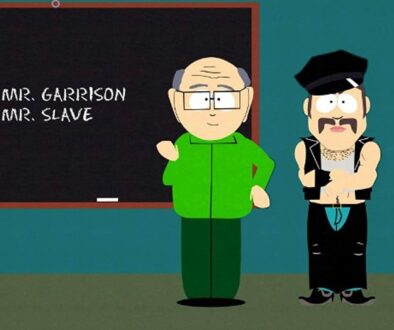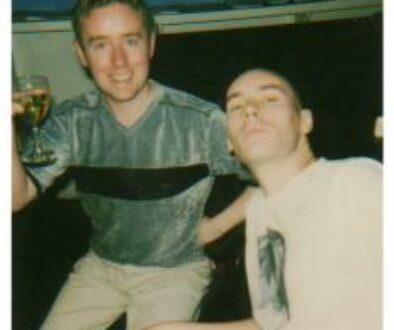In this regard it is perhaps easiest to think of The Daredevils as Marvel UK’s conscious response to Dez Skinn’s success with Warrior. While Warrior was always a mess in terms of its finances, the buzz and attention it drew turned plenty of heads. The problem was that Warrior made its name off of original content, whereas Marvel UK was still first and foremost a company that existed to publish reprints of American comic books. And so for all that The Daredevils was Marvel’s attempt to create a magazine for adult comic fans who liked Warrior, it had to do so without actually having the budget to publish original British material like Warrior. All it could afford for original comics content was Moore and Davis’s Captain Britain strip.
 |
Figure 354: Two of Alan Davis’s major
characters on the cover of Arkensword,
a major UK fanzine. |
And so it focused on its non-comics text pieces, taking a cue from the fanzine culture that existed within the UK. Fanzines – a portmanteau of “fan” and “magazine” – are fan produced publications discussing popular media, often though not always within the broad auspices of “geek culture,” with comics being a particularly common focus, although fanzines focusing on all sorts of popular culture exist. Ostensibly distributed at cost with no profit being involved, fanzines were typically distributed either by mail order or at conventions, and proved a training ground for numerous creators: Dez Skinn, Alan Moore, Steve Moore, and Grant Morrison all did work for or on fanzines early in their career. Featuring a mix of original cartoons, fan fiction, interviews, historical features, reviews, criticism, and outright whimsy, fanzine culture was at once vibrant and strange.
 |
Figure 355: Brother Power the Geek,
written and drawn by Joe Simon,
lasted only two issues. |
And, perhaps more to the point, was something The Daredevils actively kept track of with its Fanzine Reviews column. Indeed, that column gives a sense of the broad inventiveness of fanzines as it describes their contents: interviews with war comic artist Joe Colquhoun and Kevin O’Neill, fan fiction, reviews of Carl Sagan’s Cosmos, comics by Eddie Campbell, a retrospective on Steve Ditko’s Hawk and Dove comic for DC, trivia quizzes, satirical comics about Doctor Who, an episode guide to the 1960s Batman series, a compendium of ludicrous dialogue from the same series, an article on DC’s 1968 Brother Power the Geek (‘one oft he most brain-blisteringly awful comic books ever produced by human beings,” Moore explains), reprints of iconically dumb comic book panels, a review of Zippy the Pinhead, a cover by Bryan Talbot, and a one page strip by Savage Pencil are all specific features mentioned among the reviews of dozens of fanzines. Many of the text features throughout The Daredevils would have been perfectly at home among any number of these features, although largely those on the more serious-minded end of what was a diverse fanzine culture.
Implicit in this is the fact that The Daredevils was consciously targeting an older audience, and, at 65p, had a price point to match. This, in turn, explains the magazine’s title feature, reprints of Daredevil comics from Frank Miller’s iconic run on the title from 1979-83, first as an artist and then, later, as a writer-artist. Within American comics, Miller’s Daredevil run was transformative. For all that Marvel Comics honored the long legacy of exploiting creative labor in American comics, one of the most significant differences between Marvel and DC when Marvel began launching their books was the focus on the creators of those books. DC spent the early 1960s still crediting its Batman comics to Bob Kane, who was only ever a co-creator of the character, and who used a series of uncredited ghost artists on the strip, while titles like Justice League of America went out with no creator credits at all. Marvel, on the other hand, not only gave credits to its creators, it reveled in them. A Doctor Strange strip would not just be credited to Stan Lee and Steve Ditko, but would proclaim the comic to be written by “Stan Lee, Master of Macabre Menace” and drawn by “Steve Ditko, Weaver of Wondrous Witchcraft,” whereas an issue of Fantastic Four might be by “Smilin’ Stan Lee and Jolly Jack Kirby.”
 |
Figure 356: Frank Miller’s debut on
Daredevil (From Daredevil #158, 1979) |
But the rise of Frank Miller on Daredevil took this auteur-based model of comics further than anyone had previously done in the American industry. By the time Miller came onto the book as penciller in 1979, Daredevil was a middling title of little interest to much of anybody. His initial creative partnership with writer Roger McKenzie was rocky at best, and Miller nearly quit the book only to have editor Dennis O’Neil correctly discern which of McKenzie and Miller was the biggest talent and sack McKenzie instead, giving full creative control to Miller. Almost immediately, Miller turned sales around and went on to write the book for a twenty-three issue that still stands as one of the most acclaimed comics runs of all time.
Miller’s work is typically described in terms of its “noir” look, a description that, while not strictly speaking inaccurate, is not quite the whole story. The most noir touches of Miller’s Daredevil work are largely the province of inker Klaus Janson and colorist Glynis Wein, who took Miller’s pencils and build a chiaroscuro world of moody shadows out of them. But it is true that Miller’s art is aware of light and shadow in a way that few other artists of the time were, giving his pages a grim edge that stood out. And certainly once Miller took over writing the book his tales of femme fatales and assassins playing out in the rooftops and back alleys of Manhattan showcased his longstanding interest in noir.
 |
Figure 357: Miller showed Daredevil’s dynamic motion by
adding numerous shadow versions of the character to a
single panel. (Written by Roger McKenzie, art by Frank
Miller, from Daredevil #163, 1980) |
But initially what jumped out about Miller’s style was an altogether subtler thing: he favored smaller panels featuring close-ups where his predecessor on Daredevil, the legendary Gene Colan, favored bigger and more action-packed panels, focusing on full body shots of characters in dynamic poses. Miller, on the other hand, frequently favored a long series of small panels each showing a close-up details of action, so that instead of a big panel of Daredevil in costume there’s a series of small panels of Matt Murdock breaking his cane down into a billy club, pulling on the mask and a red glove, taking the costume off a hanger, et cetera. Instead of the normative comics approach of action panels featuring big, dynamic movements, Miller would draw Daredevil writhing and twisting in midair, often including intermediate poses in a lighter outline, thus giving a much broader sense of motion and dynamism.
 |
Figure 358: Alan Moore singled this selection of panels
as a high point of Frank Miller’s art. (Written by Roger
McKenzie, from Daredevil #164, 1980) |
The result produced some truly impressive scenes. Alan Moore, talking about Miller’s work in the first issue of The Daredevils, highlights a sequence from Daredevil #164 in which a reporter figures out Daredevil’s secret identity, confronting Daredevil with it by challenging him to describe a photograph he holds up to him, and thus proving that Daredevil is blind. As Moore describes it, “in six tiny, narrow frames we see Daredevil turn first one way and then the other as if in an attempt to escape having to admit that he cannot see the picture, which remains unmoving and unwavering in the foreground throughout the entire six frame sequence. Eventually Daredevil is forced to turn and face it, admitting his blindness. Through the way in which Miller arranges the shots we are made to feel the anguish of Daredevil’s decision in a manner which makes the speech balloons almost redundant.” Elsewhere he praises a pair of wide-shot panels in which some low-life gangsters are shooting pool, and a single red-gloved hand reaches out of the darkness to stop their shot as Daredevil begins asking questions. This use of small moments as the transitions between panels is trademark Miller, and moves the focus away from the big colorful action scenes and towards an intimate and more anxious sort of storytelling.
 |
Figure 359: This page, from Frank
Miller’s first issue of Daredevil as a
writer/artist, features a staggering
fourteen panels. (From Daredevil
#168, 1981) |
Once Miller took over as writer as well his propensity for small, tightly composed panels only increased. Pages with a dozen or more panels became increasingly common, many of them tiny and narrow panels capable of showing only one or two objects. In this regard Miller brought the cinematic technique of montage to the comic book page, so that the action takes place not in gaudy splash panels, but in the gaps between panels, as an action of implication. It was, for the time, a startlingly mature and developed take on the medium, and one that garnered a lot of attention, much of it focused on Miller as a comics auteur. The appeal was not, in other words, Daredevil itself, nor the consistency of the Marvel line (as was the case in the days of Lee and Kirby), but rather on Miller as a singular talent – one whose readers would follow him to other companies and to creator-owned work like Ronin that featured no established characters at all. Miller had become a figure adopted by serious comics fans, with a reputation that rapidly spread beyond just comics fans and into the general public – a transformation of the American comics landscape that Moore would soon find himself taking full advantage of.
Over time, Moore’s Captain Britain work changed to where it was more in tune with its darker co-feature (although Moore never fully embraced the neo-noir of Miller’s approach either in Captain Britain or in his later work, and indeed wrote a sly sendup of Miller’s style for The Daredevils #8 entitled “Grit”). While the beginning of the Special Executive plot was energetically psychedelic, after the first two installments the strip began advancing the subplot of Linda McQuillan, the disappeared Captain UK from the Earth on which Captain Britain died. While Captain Britain is off having whimsical adventures with the solidly entertaining Special Executive, both the Fury and the rise of “Sir James Jaspers,” this Earth’s equivalent to Mad Jim Jaspers from the Marvel Super-Heroes days of the strip. As Jaspers rises to political prominence giving a speech about how superheroes “are frighteningly powerful and they are not our friends,” Linda explains that this is the exact speech that the Jaspers on her Earth gave before the world went horribly wrong and descended into a fascist horror. As Merlin and Roma make their reappearance as well, the Fury finally attacks. The resulting two-issue battle kills two of the Special Executive and results in Wardog having his arm ripped off, and ends with the Special Executive storming off, abandoning Captain Britain to solve all of this himself.
 |
Figure 360: The Special Executive walks off into the
snow, bringing an end to The Daredevils. (Written
by Alan Moore, art by Alan Davis, from “But They Never
Really Die,” in The Daredevils #11, 1983) |
This also serves as the end of The Daredevils, with Captain Britain being migrated to The Mighty World of Marvel, which, for four issues, branded itself as The Mighty World of Marvel Featuring the Daredevils, with the Fanzine Reviews and Night Raven features following Captain Britain over, along with the serialization of the 1982 Chris Claremont/Frank Miller Wolverine series, which, although The Mighty World of Marvel was up to the third issue when The Daredevils merged in, was still, due to Miller’s art, firmly within the aesthetic of The Daredevils as well. As when moving from Marvel Super-Heroes to The Daredevils, Moore used the occasion to move his storyline forward significantly. “But They Never Really Die” leaves off with Jaspers as a looming threat who has seemingly just begun to understand his powers, while “The Candlelight Dialogues,” the first story in The Mighty World of Marvel, begins with Jaspers already in charge and having instituted detention camps for superhumans. More than that, it marks a sizable jump from where the previous story left off. The final panel of “But They Never Really Die” is the Special Executive trudging off into the snow, whereas “The Candlelight Dialogues” consists entirely of two superhuman prisoners swapping stories about Captain Britain in the hopes that someday he’ll come and rescue them, with Captain Britain only appearing as a feature of their tales and the Special Executive not even being mentioned.
Behind this jump is another issue. The end of The Daredevils coincided with the departure of editor Bernie Jaye, who had been integral to Moore’s deep involvement with the title. Moore went so far as to write a letter for the letter column praising her on the occasion of her departure. Certainly the two had a warm working relationship – so much so that Moore refers to “her insane offer to pay for some original work out of her own pocket when it didn’t look as if the budget was going to stretch far enough,” an offer he ultimately responded to by crafting large swaths of the extra material for The Daredevils “for next to nothing” and agreeing to “give her more artwork or more scripts for the same money. Jaye, in an interview, described Moore as “a consummate professional” for whom “nothing was too much trouble.” Her departure, over the fact that The Daredevils was merged into The Mighty World of Marvel without anyone talking to her about it, was a blow for Moore, and the jump to a climactic showdown between Captain Britain and Jaspers as soon as she departed feels very much like an attempt to speed up the tail end of his plot so he could be done faster. Moore was by this point able to be selective about what work he took – he was by this point writing Swamp Thing and making substantially more money from that than anything in the British market. This financial security allowed him, for the first time in his career, the luxury of being selective in his work, and like his Future Shocks for 2000 AD, his Marvel UK work simply became something he was uninterested in pursuing further. Indeed, “A Funeral on Otherworld” was his last work for Marvel, with whom he would eventually have an irrevocable falling out over the trademark to the name Marvelman that ended with Moore cheekily changing the name to Miracleman, the name of the Marvelman clone he wrote into the backstory of Captain UK.
 |
Figure 361: The bizarre and surreal fight
between Mad Jim Jaspers and The Fury
(From The Mighty World of Marvel #12,
1984) |
None of this is to say that the resolution was rushed – Moore still turned out an additional sixty-three pages of story over seven issues, including a fifteen page penultimate installment in which the Fury figures out a way to kill Jaspers before being killed by Captain Britain and, ultimately, Captain UK, who finally puts her fears aside and wades into battle against the machine that killed her husband. And perhaps more to the point, Moore’s work in these final seven installments is as complex and nuanced as anywhere else in his run. The climactic “Endgame” features one of the most outlandishly creative fights in the history of superheroes as the hyper-adaptable Fury and the reality-warping Jaspers battle, with Moore visibly delighting in giving Davis ridiculous things to draw such as the moment when “the asylum-god transmogrifies into a metal cloud, the cloud becomes a harp of molten glass, the glass grows feathers, sprouts teeth, extends luminous claws, and tries to kill the thing that cannot die.” One double page spread includes scenes set on the moon, the bottom of the ocean, the sun, “a river of tar in a landscape of chromium,” and “a plain of fused and cryptic flesh.” Moore had been building towards this conflict for some time, and he pays it off in full with a suitably epic finale, culminating in a crazed and tearful Captain UK tearing at the Fury, smashing it into smaller and smaller pieces until Captain Britain finally pulls her off, saying, “it’s dead, Linda. It’s been dead for ten minutes. You killed it.”
 |
Figure 362: Culture Club was fronted by the androgynous
Boy George. |
It is necessary in discussing the concluding period of Moore’s run on Captain Britain to pause for a moment on the month of October, 1983, specifically the 21st of the month. To begin a broader picture. The Daredevils hovers between issues #9 and #10 (both #10 and 11 are dated November, while #9 is dated September). Moore has completed Skizz and published his last Future Shock, and is still two months away from bringing back D.R. & Quinch. Warrior is up to issue #14, with “The Veil” and “One of Those Quiet Moments” by Moore, the first Bojeffries Saga having wrapped in the preceding issue. And Moore has been working on Swamp Thing for two months, although he’s still a month out from his first issue being published. Margaret Thatcher is four months into her second term. Culture Club are at number one with “Karma Chameleon,” with Siouxsie and the Banshees (“Dear Prudence”) and David Bowie (“Modern Love”) also charting.
On October 21st, Moore attended a Comics Mart in Glasgow. An account of this trip is printed in Mighty World of Marvel #9 under the title “I Belong to Glasgow,” alongside the Captain Britain strip “Among These Dark Satanic Mills,” a title that quotes Blake’s poem “Jerusalem” about attempting to build Jerusalem (by then imagined as Liberty, the emanation of the giant progenitor of all humanity Albion) within England via a mental war of creative effort. There he met a twenty-three year old comics fan and sometime writer named Grant Morrison. [continued]













June 13, 2014 @ 2:26 am
Cliffhanger! Also, thanks for the Daredevil stuff… Frank Millers run isn't my favourite, but it's hard to see Daredevil surviving into the 21st Century without him.
June 13, 2014 @ 4:57 am
I forget whether I've shared my Frank Miller's version of The Hobbit before.
June 13, 2014 @ 9:23 am
Very good 🙂
I'm now wondering what a Watchhobbits version would be like?
Dragon carcass in alley this morning. Cart track on burst stomach. Laketown is afraid of me. I have seen it's true face.
June 13, 2014 @ 10:15 am
Culture Club are at number one with “Karma Chameleon,” with Siouxsie and the Banshees (“Dear Prudence”) and David Bowie (“Modern Love”) also charting.
Sometimes I wish I hadn't been only 9 years old for this period of music. On the other hand, that might have been the perfect age for it.
June 13, 2014 @ 10:30 am
I think it is given to only a few people to be truly in the right moment at the right age for the music of their era.
I was too young for punk, I thought the new romantics looked silly, at about age 16 in 1988 I wanted to be in London in 1967 and because of that I missed out on acid house and early 90s indie completely. The only musical scene I was in tune with was Britpop, and nowadays everyone seems to be queuing up to say how crap it was. Which, by the way, it wasn't, at least not at first.
But these things go in phases. Give it 10 years and there'll be a reappraisal; my CD collection will suddenly seem cool again, and I'll be able to dine out on my tales of seeing Mansun at the Norwich Waterfront in front of an audience of reverent hipsters.
June 13, 2014 @ 10:41 am
The New Romantics DID look silly. And at age 9, silly was exactly how I wanted all my musicians to look.
I was pretty well in sync, I think, or at least I found a niche that worked for me in pretty much every era. I missed out a bit on rave culture but that might not have been a terrible thing. The reason I wish I hadn't been 9 during the zenith of new wave / post-punk was that I loved the music but was too young to go to concerts. Oh well.
June 13, 2014 @ 11:09 am
I didn't even really know post-punk was a thing until I was in my late 30s. I'd heard of bands like Magazine and all that, but never listened to them. Then I downloaded "Real Life" one day and was just blown away by how brilliant it was. I'm reconciled to it all now; I've spent the last few years getting hold of increasingly obscure late 60s psychedelia, and I no longer have any idea who is actually making music NOW. Ask me in 20 years, on the other hand, and I'm sure I'll be up to speed.
June 13, 2014 @ 11:46 am
Miller's first run on Daredevil isn't my favorite, though as you say, it really defined the character going forward. However, his second run as writer, with David Mazzuchelli on art might be the best that book has ever been.
As someone who practically pestered you to talk about Miller, Phil, I'm quite pleased with your take here. I'm especially glad you didn't reduce him to just grim'n'gritty noir and misogyny. Not that I expected you to do so, sadly Miller seems to have reduced himself to just that in the ensuing decades.
June 13, 2014 @ 1:44 pm
Off-topic, but… you may like this: https://www.youtube.com/watch?v=p9IOMn1bspw 😉
"It's funny… I thought if you could hear me, I could hang on somehow… silly me. Silly old Doctor…"
June 13, 2014 @ 7:06 pm
So yesterday, quite by accident, I stumbled across the "Hypercrisis", the theoretical Grant Morrison epic that fuses together everything he's ever written for DC (plus The Killing Joke, plus Batman: Venom, plus the original Batman of Planet X storyline) with the intent of giving the newborn sentient DC Universe a conscience, apparently for the purpose of having a threesome with it. I feel like I'm maybe closer to understanding his end of the War by now.
June 13, 2014 @ 10:57 pm
I have never been in sync with the music of the times. I could say I was too young for punk (the children two years above me in school were the ones who got it), but then I wasn't really listening to the same stuff as my contemporaries either. When I reached sixth form I got into early Judas Priest and AC/DC (alongside my existing taste for Paul Robeson and classical rather than replacing it), but not the stuff they were producing at the time. When I went to college/uni in 82, I got into prog rock bigtime with a side helping of ('70s) punk. The story continues in the same vein.
I listen to more current stuff now thanks to my children (mostly my daughter), though not quite mainstream – Skinny Lister, Pentatonix, Steam Powered Giraffe – but I still fall back on old favourites. And Ive seen lots of bands (including Magnum, actually) when they were "past their prime" in my mind.
Latest YouTube discovery: Rachel Flowers playing Steve Reich's Piano Phase. Amazing!
June 13, 2014 @ 11:42 pm
Ha! Great stuff, BerserkRL. Triturus, how about going in a different direction? 1960s Batman show?
Bilbo: Holy bark, Thorin!
Thorin: Yes, Bilbo. Treed by a crowd of cunning canines. This could be the end for us, my pedigree chum.
Announcer: Is it the end for our gallant band of daring dwarfs and their hairy hobbit helpmate? Will they find a way to escape this fiendish trap, or will the wargs wolf them down? Tune in tomorrow – same bag-time, same bag-channel!
June 14, 2014 @ 2:07 am
Quick! To the Eaglemobile!
January 25, 2021 @ 11:32 pm
I was an intern to Bernie Jaye for a couple of issues of the Daredevils. Just to add comment on the respect she had for Moore, I found what I believed to be a small spelling mistake in a Captain Britain strip that was about to go out to the printers. Rather than allowing me to just make the change of two letters, Bernie insisted that I phone Moore at home and make sure. Additional comment: I do remember in the top drawer of the desk that I worked at in her office were some sample text stories that fit into world of Captain Britain written by Grant Morrison whose name I recognized from Near Myths.